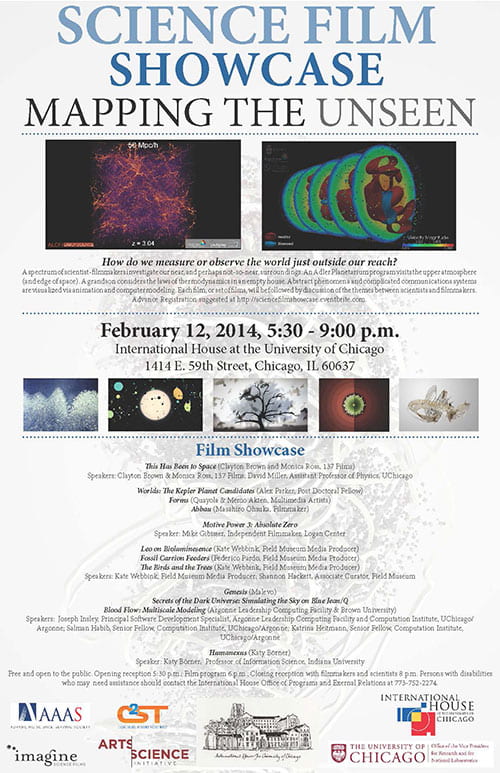Wednesday, February 12, 2014
5:30PM
Assembly Hall
How do we measure or observe the world just outside our reach? In this program, presented by Imagine Science Films, a spectrum of scientist-filmmakers investigate our near, and perhaps not-so-near, surroundings. An Adler Planetarium program visits the upper atmosphere (and edge of space). A grandson considers the laws of thermodynamics in an empty house. Abstract phenomena and complicated communications systems are visualized via animation and computer modeling. Each film, or set of films, will be followed by discussion of the themes between scientists and filmmakers.
The evening will include an opening reception from 5:30-6PM, film discussion program from 6-8PM, and a closing reception with filmmakers and scientists from 8-9PM.
Block 1, doc, 17 minutes
This Has Been to Space (Clayton Brown and Monica Ross, 137 Films)World Premiere! Join the Adler Planetarium and 25 young scientists as they send measuring instruments, and personal effects, to the very edge of outer space.
Block 2, Visualizing Science shorts, 13 minutes
Five variations on visualizing scientific information through animation and computer simulation.
Worlds: The Kepler Planet Candidates (Alex Parker, Postdoctoral Fellow, Department of Planetary Astronomy, University of California at Berkeley
Winner of the CERN/Cineglobe prize for data visualization at the Imagine Science Film Festival, a breathtaking representation of the vast and diverse collection of planet candidates identified by the Kepler telescope.
The Birds and the Trees (Kate Webbink, Field Museum Media Producer)
Science is a constant revision process, one that may occasionally strand a condor in the stork display.
Genesis (Malevo)
Organic life grows and evolves in abstracted movements.
Forms (Quayola & Memo Akten, Multimedia Artists
Human biophysical data remapped as elegant digital sculpture.
Mammoths and Mastodons (Angle Park, Museum Multimedia)
Vividly envisioning the Pleistocene.
Block 3, experimental doc, 8 minutes
Motive Power 3: Absolute Zero (Mike Gibisser, Independent Filmmaker, Logan Center)
Mike Gibisser’s Motive Power series is personal-poetic investigation of the three laws of thermodynamics, each set in a single street location and contextualizing abstract principles in the concrete details of family and home.
Block 4, Field Revealed shorts, 10 minutes
The Field Museum’s in-house filmmakers take us through the museum’s collections and current concerns.
Leo on Bioluminesence (Kate Webbink, Field Museum Media Producer)
Bioluminescence in diverse deep-water marine life is well documented — but why did it evolve?
Fossil Carrion Feeders (Federico Pardo, Field Museum Media Producer)
Turning to Chinese fossils to better understand a family of modern carrion beetles.
What’s In a Name? (Kate Webbink, Field Museum Media Producer)
The ongoing story of taxonomy.
Block 5, Digital Planet, 8 minutes
The Field Museum’s Digital Planet program provides teen filmmakers with the resources and access to produce inventive original films from the museum’s incredible collections.
Journey to the Jar
Koalas and Carbon Dioxide
Out of the Darkness
The Life of Sue
Wormance
Block 6, doc animation, 12 minutes
Humanexus (Katy Börner, Professor of Information Science, Indiana University)
This animated history tracks human communications and information exchange from prehistory into very-near-future in order to ask of our technological progress: “Is this what we want?”
This event is free and open to the public.
Sponsored by the Global Voices Lecture and Film Series and Imagine Science Films.
